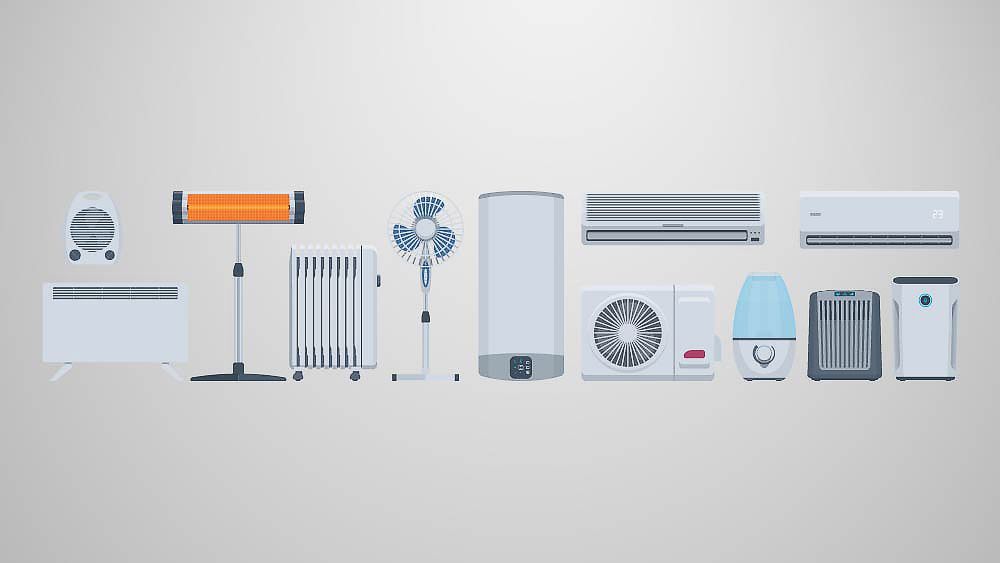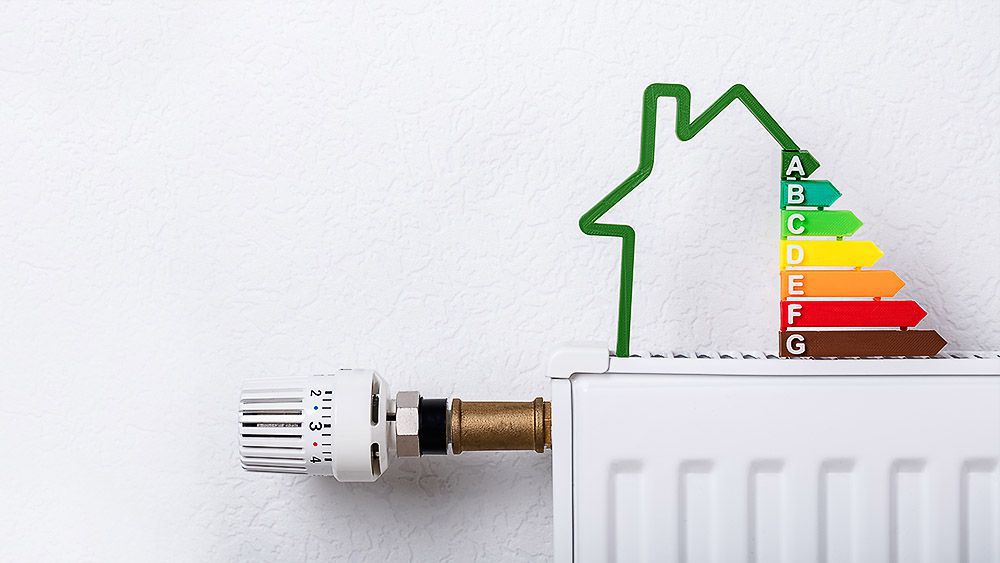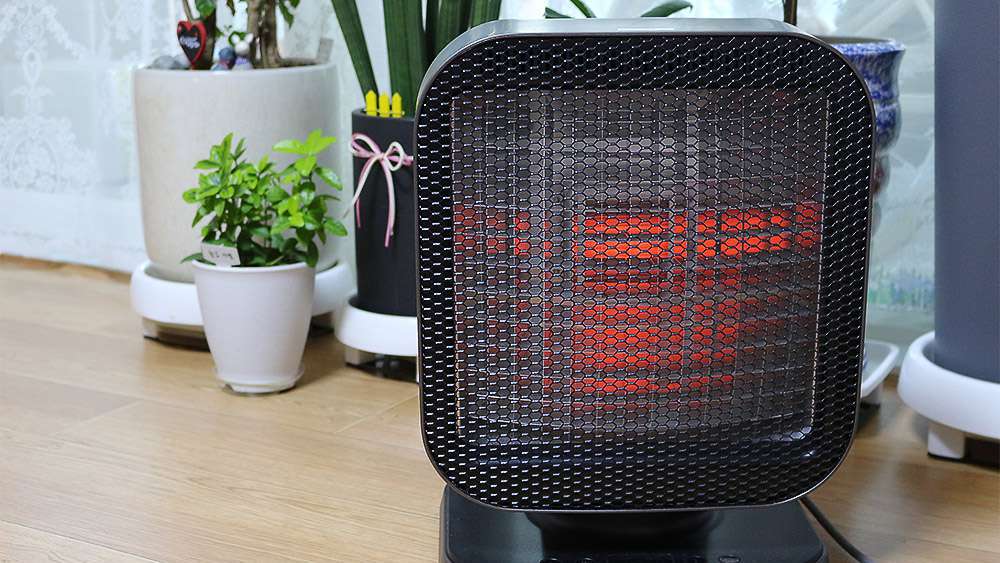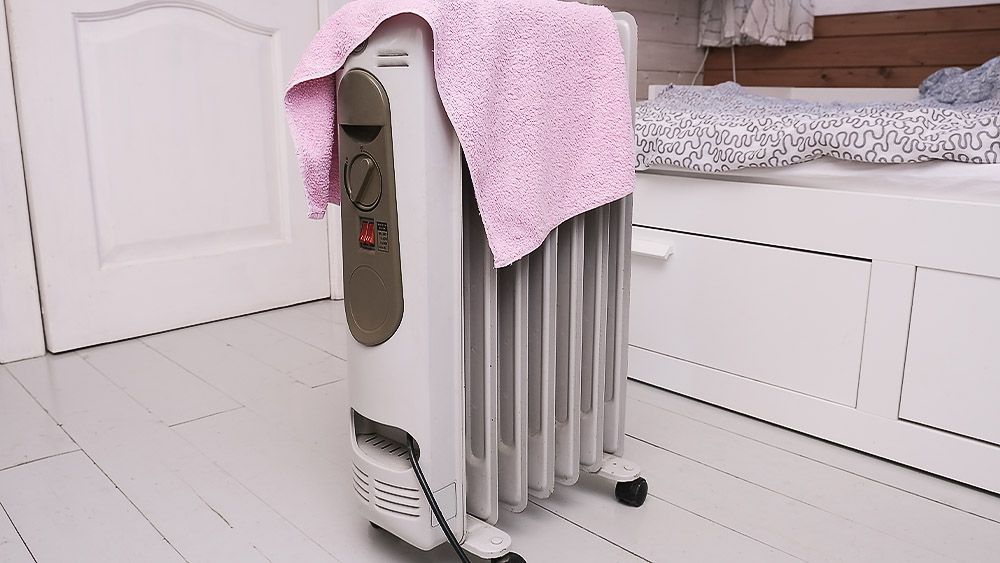
Key Takeaways
- Optimal office temperature enhances productivity by improving focus and efficiency.
- Space heaters offer targeted comfort with various types for different office heating needs.
- When selecting office space heaters, it’s essential to consider safety features such as tip-over protection and overheat shut-off.
Office heating can be a godsend on cold winter days. Whether you have a personal office area, an open floor working environment, or a home office setup, nothing beats walking into a toasty space when it’s negative degrees outside.
In addition to comfort, temperature significantly impacts employee performance. A space that is too hot or too cold can make it hard to focus on work, resulting in a drop in productivity and efficiency.
The blog dives into how temperature can supercharge or sap your productivity, reveals ingenious ways to stay warm, and features a curated list of the top space heaters. Plus, it guides you through picking the perfect one for your needs!
- Office Temperature and Productivity
- What Is the Ideal Office Temperature?
- Office Heating Laws
- What to Do if Your Office Is Just Too Cold?
- What Are Office Space Heaters?
- Types of Space Heaters
- 10 Best Space Heaters for Offices
- How to Choose the Best Office Space Heater?
- Space Heater Safety Tips
- Office Heating: Is It That Important?
Office Temperature and Productivity

Office heating and cooling systems are critical for regulating temperatures and keeping all employees comfortable and productive. When employees are comfortable, they can concentrate on their work without being distracted by the heat or cold.
When temperatures rise above the ideal temperature range, cognitive functions such as memory and attention can decline, and workers may experience fatigue and irritability. Conversely, if temperatures drop too low, it can lead to decreased manual dexterity and slower reaction times, further hindering performance.
Temperature can also affect mood and health, and your environment impacts your decision-making abilities.
Proper temperature adjustment leads to a more efficient, engaging, and happy work environment. But what is the perfect temperature for your office?
Related: Office Air Conditioning and Productivity – Are They Related?
What Is the Ideal Office Temperature?

The US Occupational Safety and Health Administration (OSHA) recommends office temperatures around 68F to 76F.
It’s important to note here that individual preferences vary, and other factors affect temperature needs. For instance, if some desks at your workplace get more sunlight than others, then you might not rely on the office heater for warmth on these desks. But if you sit at a desk with no sunlight, you will most likely want to turn the heating up.
Related: The Ideal Room Temperature for Every Situation
Similarly, many other factors, such as age, gender, body weight, and humidity levels, also affect temperature needs. This difference in preferred temperature can lead to vicious thermostat wars among coworkers.
Most office spaces are now looking into zoning systems to overcome this issue. This system uses multiple thermostats in different parts of your workplace to control temperature.
Your best choice to make any mini-split, window,
or portable AC smart. Enhance your comfort and savings.

Office Heating Laws
With temperature playing such a crucial role in employee productivity and safety, you probably expect a law in place to enforce a suitable temperature mandate. Unfortunately, there are no laws that impose or require offices to maintain a specific temperature. The primary reason is that some offices have equipment or products they need to store at particular temperatures, even if the employees in that office don’t like that temperature.
While there are no legal requirements to convince your employer to turn the office heating up, employers are obligated to provide their employees with a comfortable and safe working environment according to the Occupational Safety and Health Administration (OSH) Act of 1970. So, if you’re a little too cold (or even too hot), it might not be a bad idea to talk to your HR about it.
If you manage to persuade your workplace to upgrade the office heating system, they may turn to you for recommendations. Don’t worry, though—it’s all covered!
What to Do if Your Office Is Just Too Cold?

Most offices these days have at least one main heating or cooling system to keep their employees comfortable. However, this primary system can sometimes prove ineffective, and there can be numerous reasons for this.
For instance, the building could have cold and warm spots depending on where the sun streams. Or perhaps the type of insulation is not good enough. Some areas are located further away from the main heating or cooling system than others.
To remedy this, you can utilize various strategies. These include:
-
Layered Clothing
Wearing layers allows you to adjust your body temperature easily. Start with a base layer to keep moisture away from the skin, add a middle layer for insulation, and finish with an outer layer for protection against drafts.
-
Desk Accessories
Heated desk accessories, such as heated mouse pads, footrests, and seat cushions, can provide targeted warmth to specific parts of your body, enhancing overall comfort without affecting the entire office’s temperature.
-
Adjust Office Layout
Rearranging the office to minimize exposure to cold drafts from windows or doors can significantly improve warmth. Place workstations away from these areas and use partitions or screens to block drafts.
-
Warm Beverages and Foods
Consuming warm beverages like tea, coffee, or hot water and eating warm meals can help maintain your body temperature. Keeping a thermal mug and a variety of instant hot drinks at your desk can provide quick warmth throughout the day.
-
Space Heating
Introducing personal space heaters can provide individuals with greater control over their immediate climate comfort. This option allows employees to adjust temperatures at their desks according to their preferences, enhancing overall satisfaction and productivity.
What Are Office Space Heaters?

Space heaters are portable devices designed to heat small to medium-sized areas. They are commonly used in situations where central heating is insufficient or unavailable. In offices with inadequate central heating, space heaters can provide additional warmth in specific rooms, making them more comfortable without needing to heat the entire building. They are also an ideal method for localized and targeted heating and can save on energy bills when heating up the entire office is not necessary.
Types of Space Heaters
Space heaters come in various types, each suited for different heating needs and environments. Here are the most common ones:
1. Convection Heaters
Office space heaters operate using convection technology to distribute warm air. An electric heating element heats the air, causing it to rise and exit through the top of the unit. This process draws cooler air in through the bottom vents, ensuring continuous circulation.
|
Pros |
Cons |
|
|
|
|
|
|
|
|
2. Radiant Heaters
Radiant heaters, or infrared heaters, work by emitting infrared radiation that directly warms objects and people in their path. They are perfect for spot heating and immediate warmth, making them suitable for small areas, individual desks, or outdoor spaces. Since they don’t heat the air but rather the objects and people directly, they are very efficient for targeted heating and do not waste energy heating unoccupied spaces.
|
Pros |
Cons |
|
|
|
|
|
|
3. Ceramic Heaters
Ceramic heaters use ceramic plates and aluminum baffles to produce heat, which is then dispersed by a fan. They heat up quickly and provide effective, focused heating. These heaters are compact and portable, making them a popular choice for personal use in bedrooms, offices, and small living areas. Some ceramic heaters also include oscillation features to distribute heat more evenly across a room.
|
Pros |
Cons |
|
|
|
|
|
|
4. Propane Heaters
Propane heaters are fuel-powered and are often used in spaces where electricity is unavailable or impractical. They are highly portable and can provide substantial heat quickly, making them ideal for garages, workshops, outdoor patios, and camping. However, proper ventilation is essential when using propane heaters indoors to prevent the buildup of carbon monoxide and other harmful gases.
|
Pros |
Cons |
|
|
|
|
|
|
|
|
5. Fan Space Heaters
Fan space heaters are popular for their ability to rapidly warm small areas. Fans using this technology work in a straightforward manner. Electricity heats a metal coil and a fan, then propels hot air into the room.
|
Pros |
Cons |
|
|
|
|
|
|
6. Oil-Filled Space Heaters
These devices feature metal tubes filled with oil, designed to mimic the appearance of traditional steam or water radiators found in older homes. Electrical energy heats the oil in the tubes, which then radiates heat to warm the space, similar to old-fashioned radiators.
|
Pros |
Cons |
|
|
|
|
|
|
Having so many options can make choosing the best office space heater quite tough. Fortunately, though, certain factors influence the choice, and understanding these will make it much easier for you to make the right decision.
10 Best Space Heaters for Offices
We’ve compiled a list of the ten best office heaters that you can choose from:
1. Lasko 754200 Ceramic Heater
The Lasko 754200 Ceramic Heater has been around for a long time, and it has garnered praise for being one of the most reliable yet affordable space heaters. This fan heater has a compact body and is surprisingly lightweight. Like many other Lasko heaters, this model is also super quiet and has impressive safety features such as automatic shut-off and an exterior that always stays cool. You can fit it under your office desk to keep your toes toasty.
2. Vornado MVH Vortex Heater
Another forced air space heater option is the MVH from Vornado. This office space heater works by heating air over a circular resistance coil and using a three-blade fan to distribute heat evenly across your room. The MVH can heat slightly larger office spaces, making nearly no sound. In addition to these perks, this office heater has a cool-to-the-touch exterior, automatic shut-off, and tip-over safety that shuts the device off if it falls over.
3. Amazon Basics 500-Watt Ceramic Small Space Personal Mini Heater
Amazon Basics Ceramic Wall space personal heater comes in four colors: white, black, pink, and blue. While the heater may appear tiny, it packs quite a lot of heat and is great for placement on any desk or even on the floor. It heats up pretty quickly and has a tip-over safety feature.
4. Lasko Compact Heating Space Heater
Lasko Compact Space Heater only uses 200 Watts of power and is great for small office spaces. It’s also super quiet, so you can run it on your desk in a shared office space without disrupting anyone else’s workflow.
5. GiveBest Portable Electric Space Heater
There’s a reason GiveBest Portable Electric Space Heater is one of Amazon’s best-selling space heaters. The 2-in-1 ceramic heater fan offers two heat levels (1500W and 750W) and a cool air fan, making it suitable for both winter and summer use. Its thermostat control automatically turns the heater off when a preset temperature is reached and back on when the temperature drops. The multi-protection safety system includes flame retardant materials to prevent fire hazards, an automatic shutoff for overheating, and tip-over protection that shuts the heater off if knocked over, automatically turning it back on when uprighted.
6. De’Longhi Mica Thermic Panel Heater
If you’re looking for a stylish yet efficient office heating solution, look no further than the De’Longhi mica thermic panel heater. This freestanding heater is perfect for small or medium-sized offices. It uses a mica thermic element to supply constant heating with no noise output. You can easily mount this lightweight office space heater on any wall to keep people from accidentally kicking it. But you needn’t worry because this heater comes with a tip-over safety feature to shut off if it even falls on its face. It also has a bunch of other features, such as an adjustable thermostat and two heater settings.
7. Cozy Products TT Toasty Toes Ergonomic Heated Foot Warmer
What could be better than a footrest that keeps your feet warm? This Toasty Toes heater does exactly that. Not only does this let you choose what angle you want the footrest to be at, but it also enables you to pick from different temperature settings. In addition, it’s surprisingly cheap and only uses 105 watts of power to run, making it an energy-efficient option in the long run. Overall, the low power consumption, safety features, and compact design make this space heater an ideal office heating solution for just about anyone.
8. Lasko 755320 Ceramic Space Heater
Equipped with a timer, a programmable digital temperature setting, and an oscillating design, this Lasko ceramic space heater is perfect for slightly larger office spaces. You can set up a timer for automatic shut-off or control it via the remote, so you don’t have to walk up to it every time you want to adjust the temperature. It also has impressive safety features, such as an auto shut-down feature that turns the device off if you’ve left it running for too long.
9. Brightown Wall Outlet Space Heater
If you have a small personal office or a home office, this super-compact Brightown Wall Outlet Space Heater is perfect for you. It plugs into any wall and heats up to 100 square feet of office space. You can choose any heat setting between 60 and 90 degrees and use the built-in programmable timer to keep it running for up to 12 hours. In addition to being compact and efficient, this office space heater is also very quiet, making it perfect for open-floor office spaces.
10. Heat Storm HS-1500-PHX-WIFI Infrared Heater
This infrared space heater by Heatstorm is ideal for small to medium rooms. It goes beyond being just a personal heater and can warm up any small office cabin. If you have limited floor space, you can either mount this heater on a wall or purchase a stand separately and install the heater on the floor. In addition to a wide range of safety features, this small office heater also offers various smart features. You can control it via your smartphone and a battery-operated remote control.
How to Choose the Best Office Space Heater?
Here are some factors that you should consider before making the final call on what heater you should buy:
1. Type of Heater

The first thing to figure out is what sort of heater you’re going to need. All these heaters have their perks and downsides. The choice depends on the type of space you’re heating and what office heating system would work best in that space.
For instance, radiant heaters offer spot heating. They are ideal for open or outdoor locations that might need short-term heating. Convection heaters, on the other hand, provide heating to a whole room and work best in enclosed spaces that would require long-term heating. Forced air heaters are similar to convection heaters but much quicker at heating since they use a fan to distribute air. However, they are also noisier.
2. Heating Capacity
Another important consideration to make is the heating capability of the space heater you’re getting. If you plan on using the heater only to keep yourself warm or using it in a home office, you likely don’t need a heater with a high wattage. If, however, you plan on using the heater to keep the entire office space warm, you will need a heater with a higher capacity.
3. Energy-Efficiency

Space heaters are expensive to run. This may discourage many offices from allowing their employees to use space heaters and rely only on the primary office heating system. However, you can cut back these costs by opting for an office heater with high energy efficiency.
Some office space heaters have built-in features such as programmable timers and thermostats to be more energy-efficient. These features automatically turn your heater off after a pre-defined time or when a suitable temperature is reached. Other heaters have low wattage or energy-saving modes to lower the electricity bill.
4. Safety Features
Space heaters can be a safety hazard if you don’t take proper precautions when using them. When looking for the best office space heater, opt for one with extensive safety features. For example, the heater should have cool-to-the-touch surfaces because you don’t want to accidentally burn your feet if your heater is under your table. They should also have an internal switch that will turn them off if they overheat or tip over accidentally.
5. Noise Level

The space heater can generate either a significant or low noise level based on what mechanism the space heater uses. Forced air heaters are generally noisier because they use a fan for heat distribution. Central forced air heaters rely on ducts to get warm air from one room to another and are also pretty noisy.
Conversely, radiant heaters operate nearly noise-free and are a great choice for office spaces where anything that disrupts attention is unwelcome.
Space Heater Safety Tips

Space heaters have become a lot safer than they once were. All the same, there are still some additional precautions you can undertake to keep your office space safe. Here are the top space heater safety tips for you to follow:
- Don’t leave your heater on if you’re leaving the office, even for a short time.
- Make sure the heater is at least 3 feet away from anything that might be even slightly flammable, such as furniture, curtains, and other items.
- Keep the heater uncovered since whatever you put on it might either melt or catch fire.
- Remember to keep electric heaters away from water to avoid shocks or other catastrophes. Also, keep all space heaters away from “wet” locations unless they are approved for it.
- Avoid using extension cords or power strips with a space heater because they run on a very high voltage.
Office Heating: Is It That Important?
The perfect office heater can contribute to much more than just your comfort. Recent research has shown that having a bearable temperature at work can enhance your productivity. According to OSHA, the perfect workplace temperature falls between 68F and 76F. There are several different types of office heating systems, and they are all suited for various applications. Choosing the right system is very important because it can impact your comfort, performance, and energy costs.








